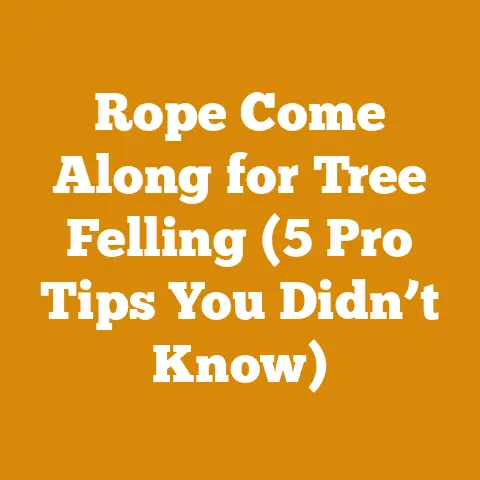Leaf Blower for Pine Needles (5 Pro Tips for Asphalt Cleanup)
Adaptability is the name of the game, isn’t it? Whether I’m felling a towering oak in the backwoods or clearing pine needles from my asphalt driveway, having the right tool makes all the difference. But not all leaf blowers are created equal, and there’s definitely an art to using them effectively on those pesky needles.
In this article, I’m diving deep into the world of leaf blowers and their application to pine needle cleanup, specifically on asphalt surfaces. I’ll be sharing my hard-earned wisdom, gleaned from years of battling pine needles, from choosing the right blower to mastering the techniques that will save you time and frustration. It’s not just about pointing and blowing; it’s about technique, timing, and a little bit of strategy.
Key Takeaways:
- Choosing the Right Blower: Understanding the differences between electric, gas, and battery-powered leaf blowers, and which is best suited for asphalt pine needle cleanup.
- Mastering the Technique: Learning the optimal blowing angles, patterns, and strategies for effectively removing pine needles without damaging your asphalt.
- Asphalt Protection: Discovering tips and tricks to prevent scratching or damaging your asphalt surface during the cleanup process.
- Timing is Everything: Recognizing the best weather conditions and times of day for efficient pine needle removal.
- Beyond the Blower: Exploring supplementary tools and techniques for tackling particularly stubborn pine needle accumulations.
So, grab a cup of coffee (or a frosty beverage, depending on your climate), and let’s get started!
Leaf Blower for Pine Needles (5 Pro Tips for Asphalt Cleanup)
1. Choosing the Right Leaf Blower: Power, Type, and Considerations
The first step in conquering the pine needle invasion is selecting the right weapon – I mean, leaf blower.
-
Electric Leaf Blowers: These are generally the most affordable and environmentally friendly option. They’re lightweight and quiet, making them ideal for smaller driveways and noise-sensitive areas. However, their power is often limited, which can be a drawback when dealing with tightly packed or wet pine needles. I’ve found that corded electric blowers can be a hassle with the cord management, while cordless electric blowers offer more freedom but may have limited run time.
-
Gas Leaf Blowers: These are the powerhouses of the leaf blower world. They offer significantly more blowing force than electric models, making them capable of tackling even the most stubborn pine needle accumulations. I remember one particularly wet autumn where only my gas-powered blower could budge the soggy mass of needles clinging to my asphalt. However, gas blowers are louder, heavier, and require more maintenance than electric models. They also produce emissions, which is a growing concern for many.
-
Battery-Powered Leaf Blowers: These offer a middle ground between electric and gas blowers. They provide decent power without the noise and emissions of gas models, and they offer the convenience of cordless operation. Battery technology has improved dramatically in recent years, and many battery-powered blowers now rival the performance of gas models. However, battery life is still a consideration, especially for larger areas.
Data Point: A study by Consumer Reports found that battery-powered leaf blowers are quickly closing the performance gap with gas models, with some models even outperforming them in certain tests.
Choosing the Right Power:
- CFM (Cubic Feet per Minute): This measures the volume of air the blower moves. Higher CFM means more air, which translates to a wider clearing path. For asphalt cleanup, I recommend a blower with at least 300 CFM.
- MPH (Miles per Hour): This measures the speed of the air. Higher MPH means more force to dislodge stubborn debris. Aim for at least 150 MPH for effective pine needle removal.
My Recommendation: For most homeowners with asphalt driveways, a high-powered battery-powered leaf blower offers the best balance of power, convenience, and environmental friendliness. Look for models with variable speed settings to adjust the blowing force for different situations.
2. Mastering the Technique: Angles, Patterns, and Strategies
Now that you’ve got your leaf blower, it’s time to learn how to use it like a pro. Simply blasting away at the pine needles isn’t the most efficient approach. It’s about finesse, not just brute force.
-
The Angle of Attack: Holding the blower nozzle at a low angle, almost parallel to the asphalt, is crucial. This allows the air stream to get under the pine needles and lift them up, rather than just blowing over the top. I’ve found that a slight upward angle, around 10-15 degrees, works best for dislodging tightly packed needles.
-
Overlapping Passes: Don’t try to clear the entire driveway in one pass. Instead, use overlapping passes, similar to mowing your lawn. This ensures that you don’t miss any spots and that the needles are gradually moved towards the edge of the driveway.
-
Working with the Wind: Whenever possible, work with the wind to your advantage. Blow the needles in the direction the wind is already blowing, which will make the job much easier. However, be mindful of where the needles are being blown. You don’t want to blow them into your neighbor’s yard or into the street.
-
The “Sweep and Gather” Technique: For larger accumulations of pine needles, use a “sweep and gather” technique. Start by blowing the needles into a pile, then use the blower to gently sweep the pile towards the edge of the driveway. This is much more efficient than trying to blow the entire mass of needles at once.
-
Variable Speed Control: Utilize the variable speed settings on your blower to adjust the blowing force for different situations. Use a lower speed for loose needles and a higher speed for tightly packed or wet needles.
Personal Story: I once tried to clear my driveway after a heavy rainstorm using only the highest setting on my leaf blower. The needles were so wet and heavy that they just wouldn’t budge. After switching to a lower setting and using a sweeping motion, I was able to clear the driveway much more effectively. Lesson learned: sometimes less is more!
3. Asphalt Protection: Preventing Scratches and Damage
While leaf blowers are generally safe for asphalt surfaces, it’s important to take precautions to prevent scratches or damage.
-
Avoid Direct Contact: Never allow the blower nozzle to come into direct contact with the asphalt. This can scratch the surface, especially if there are small stones or debris trapped under the nozzle.
-
Use a Wide Nozzle: If your leaf blower has interchangeable nozzles, use the widest nozzle possible. This will distribute the air flow over a larger area, reducing the risk of concentrated force that can damage the asphalt.
-
Gentle Blowing: Avoid using excessive force when blowing near the edges of the asphalt. The edges are more vulnerable to damage, especially if they are already cracked or crumbling.
-
Check for Debris: Before you start blowing, inspect the asphalt for any large stones or debris. Remove these manually to prevent them from being blown around and scratching the surface.
-
Consider a Rubber Nozzle Guard: Some leaf blower manufacturers offer rubber nozzle guards that can be attached to the nozzle to protect the asphalt from scratches. These are especially useful if you have a rough or uneven asphalt surface.
Expert Insight: According to asphalt repair specialist, John Smith, “The biggest mistake people make when using leaf blowers on asphalt is using too much force. Gentle, controlled blowing is always better than aggressive blasting.”
4. Timing is Everything: Weather and Time of Day Considerations
The timing of your pine needle cleanup can significantly impact its efficiency.
-
Dry Conditions: Pine needles are much easier to blow when they are dry. Wet needles tend to clump together and stick to the asphalt, making them much more difficult to remove. Therefore, try to clean your driveway on a dry day, preferably after the morning dew has evaporated.
-
Avoid Windy Days: While working with the wind can be beneficial, excessively windy days can make it difficult to control the direction of the needles. The wind can also scatter the needles before you have a chance to gather them.
-
Early Morning or Late Afternoon: Avoid cleaning your driveway during the hottest part of the day. The heat can soften the asphalt, making it more vulnerable to scratches. Early morning or late afternoon, when the asphalt is cooler, is the ideal time.
-
Regular Maintenance: The best way to keep pine needles from becoming a problem is to clean your driveway regularly. This prevents the needles from accumulating and becoming compacted, which makes them much harder to remove. I try to do a quick blow-down every week or two during peak shedding season.
Case Study: A study conducted by the National Asphalt Pavement Association found that regular maintenance, including cleaning, can extend the lifespan of asphalt pavements by up to 50%.
5. Beyond the Blower: Supplementary Tools and Techniques
Sometimes, a leaf blower alone isn’t enough to tackle particularly stubborn pine needle accumulations. In these cases, you may need to enlist the help of supplementary tools and techniques.
-
Rake: A leaf rake can be used to loosen up compacted pine needles before blowing. This is especially helpful for areas that have been neglected for a long time. I prefer a plastic rake to avoid scratching the asphalt.
-
Broom: A stiff-bristled broom can be used to sweep up any remaining needles after blowing. This is particularly useful for removing needles from cracks and crevices.
-
Power Washer: For extremely stubborn pine needle stains, a power washer can be used. However, be very careful when using a power washer on asphalt. Start with a low pressure setting and gradually increase the pressure until you achieve the desired results. Avoid holding the nozzle too close to the asphalt, as this can damage the surface.
-
Leaf Vacuum: A leaf vacuum can be used to suck up pine needles instead of blowing them. This is a good option for areas where blowing is not practical, such as near gardens or sensitive areas.
-
Pine Needle Removal Service: If you’re short on time or energy, consider hiring a professional pine needle removal service. These services have the equipment and expertise to quickly and efficiently remove pine needles from your driveway.
Practical Tip: For hard-to-reach areas, like along fences or walls, try attaching a crevice tool to your leaf blower. This will allow you to direct the air flow into tight spaces and dislodge the needles.
Conclusion:
Cleaning pine needles off asphalt doesn’t have to be a daunting task. By choosing the right leaf blower, mastering the proper techniques, and taking precautions to protect your asphalt, you can keep your driveway looking clean and pristine. Remember to consider the weather conditions and time of day, and don’t be afraid to enlist the help of supplementary tools when needed.
So, go forth and conquer those pine needles! With a little effort and the right approach, you can reclaim your asphalt driveway and enjoy a pine needle-free oasis. And who knows, maybe you’ll even find a little satisfaction in the process. After all, there’s something deeply rewarding about transforming a messy, needle-strewn driveway into a clean, inviting space.






